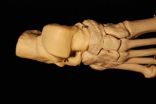(Press-News.org) SALT LAKE CITY — A team of global scientists, led by researchers at Intermountain Medical Center in Salt Lake City, has developed a safer and more accurate way to administer warfarin, one of the most commonly prescribed but also potentially dangerous medications in the United States.
As part of a worldwide study, the research team developed and tested a new formula that combines individual genetic data with a mathematical model to help physicians more accurately predict patient response to the popular blood-thinning drug.
Researchers found that the formula was safer and more accurate than current methods used to dose for warfarin patients. They're hopeful that the more accurate dosing will eliminate many emergency hospitalizations among warfarin users. Results of the team's study are published in the February edition of the journal, Thrombosis and Haemostasis.
Every year, more than two million Americans begin taking warfarin after joint replacement surgery or who have heart rhythm disorders, stroke risk, deep vein thrombosis, or other common conditions. Because patient response to the drug is so variable, it's difficult for physicians to determine safe, yet effective dosages for each individual.
The consequences can be serious: If patients get too much warfarin, they can develop uncontrolled bleeding; too little and they can suffer a stroke or a blood clot in another location.
"Physicians usually test a patient's blood once or twice in the first week after starting warfarin to see if it's clotting properly," said Benjamin Horne, PhD, director of genetic epidemiology at the Intermountain Medical Center Heart Institute and lead author of the study. "But we've shown that because of genetic variation, patient response to warfarin continues to change after the first week and dosing may need to change, too."
The research group, comprised of physicians and scientists at 13 centers in the United States, Europe, and Asia, tracked 1,342 patients on days six through 11 after beginning treatment with warfarin. The team considered factors such as individual body mass index, medication usage, age, gender, and whether or not the patients carried two genes that are known to influence the way warfarin affects the body.
From those data, Dr. Horne and his colleagues were able to create a mathematical model to predict individual patient response to warfarin. The group applied their new algorithm to 342 different patients to validate that it could accurately predict patient response to the drug and help determine more appropriate dosages.
"We discovered that the algorithm is significantly more precise and accurate in identifying the best dose for an individual patient," said Dr. Horne.
He said the body's response to warfarin stabilizes after the second week of treatment, and that the algorithm can determine the safest dose possible for the full course of warfarin treatment. Researchers believe future studies will demonstrate the financial, as well as clinical, benefits of conducting genetic tests needed to perfect the dosing for individual patients.
"This is a very hopeful first step in that direction," said Dr. Horne. "I expect we'll see more studies in the future that show the real effect this tool will have on the lives of patients."
The algorithm is the latest research on genetics and warfarin dosing at Intermountain Medical Center. An earlier project, led by Intermountain Heart Institute cardiologist Jeffrey L. Anderson, MD, examined the effectiveness of genetic testing on warfarin use.
Both group's findings are being used to build a computer tool that works within Intermountain Healthcare's electronic medical record system and that will perform warfarin calculations automatically, thereby increasing patient safety.
"This promises to be a powerful tool to tailor warfarin dosing to each individual patient," said Scott C. Woller, MD, an internal medicine specialist at Intermountain Medical Center who is helping to create the computer system. "The goal of this effort is to make patient-specific dosing algorithms as accessible as possible to busy clinicians."
INFORMATION:
Other institutions involved in this study were Washington University in St. Louis, Harvard University, the University of Utah/ARUP, Kaiser Permanente Colorado, the Marshfield Clinic, Vanderbilt University, the University of Alabama, Uppsala University (Sweden), the Karolinska Institute (Sweden), the University of Liverpool (United Kingdom), Inje University (South Korea), and Mahidol University (Thailand).
END
For more than four decades, a drug called diethylstilbestrol (DES) was prescribed to millions of expecting mothers in an effort to prevent miscarriages. Prescriptions for the drug were written until 1971, when researchers discovered a link between prenatal exposure to DES and the development of reproductive tract cancers. Notably, researchers discovered health issues of developing breast cancer not only in the expecting mothers themselves, but also in their daughters decades later after being exposed to DES in utero. These victims have come to be known as the DES daughters.
As ...
New York, February 29, 2012 – A revealing study published in Epilepsy & Behavior provides evidence that the perception of epilepsy is not faring well in social media. Kate McNeil and colleagues from Dalhousie University in Canada analyzed data collected from Twitter to provide a snapshot of how epilepsy is portrayed within the twitter community.
Twitter, a social networking platform launched in 2006, allows its users to communicate through posting of "tweets" limited to 140 characters. Twitter has gained worldwide popularity since its inception, with approximately 110 ...
Wild bees are important pollinators and numerous studies dealing with pollination of wild plants and crops underline their vital role in ecosystems functioning. While honey bees can be easily transported to various location when needed, wild bees' presence is dependent on the availability of high quality semi-natural habitats. Some crops, such as apples and cherries, and many wild flowers are more effectively pollinated by wild bees and other insects rather than managed honey bees.
Although heavy metal pollution is recognized to be a problem affecting large parts of the ...
Researchers from the Mayo Clinic confirm that ultrasound-based transient elastography (TE) provides excellent diagnostic accuracy for detecting cirrhosis due to recurrent infection with hepatitis C virus (HCV) infection following liver transplantation. Findings from the study published in the March issue of Liver Transplantation, a journal of the American Association for the Study of Liver Diseases, suggest that detection of significant fibrosis is more accurate when comparing patients with chronic HCV of the native liver.
According to the World Health Organization (WHO), ...
Law enforcement officials who are tasked with identifying a body based on partial skeletal remains have a new tool at their disposal. A new paper from North Carolina State University researchers details how to determine the biological sex of skeletal remains based solely on measurements of the seven tarsal bones in the feet.
"Tarsals are fairly dense bones, and can be more durable than other bones – such as the pelvis – that are used to determine biological sex," says Dr. Troy Case, an associate professor of anthropology at NC State and co-author of a paper describing ...
As the baby boomer generation grows older, decisions related to selling the family home and moving, in order to provide aging family members with additional care, will become increasingly important for many American families. For some, this decision will focus on two alternative housing options in particular: assisted living facilities and nursing homes. There are advantages and disadvantages to both types of housing, though both are governed by sets of laws that protect residents and ensure their proper care.
Nursing homes have gained a bad reputation over the past ...
A gluten-free, casein-free diet may lead to improvements in behavior and physiological symptoms in some children diagnosed with an autism spectrum disorder (ASD), according to researchers at Penn State. The research is the first to use survey data from parents to document the effectiveness of a gluten-free, casein-free diet on children with ASD.
"Research has shown that children with ASD commonly have GI [gastrointestinal] symptoms," said Christine Pennesi, medical student at Penn State College of Medicine. "Notably, a greater proportion of our study population reported ...
Already a prominent oil and gas state, Texas can expect its contribution to the nation's energy resources to keep growing. Take the Barnett Shale formation, for instance, near Fort Worth. The Barnett Shale already produces six percent of all natural gas produced in the entire 48 contiguous states, with more production expected.
Texas Shale Formations & Hydraulic Fracturing
Extracting trapped natural gas from the reservoirs of layered shale rock has, for the first time in just the last several years, become practical and profitable.
Conventional drilling equipment ...
DURHAM, N.C. -- Using exotic man-made materials, scientists from Duke University and Boston College believe they can greatly enhance the forces of electromagnetism (EM), one of the four fundamental forces of nature, without harming living beings or damaging electrical equipment.
This theoretical finding could have broad implications for such applications as magnetic levitation trains, which ride inches above the tracks without touching and are propelled by electro-magnets.
As the term indicates, EM is made up of two types of fields – electric and magnetic. Alternating ...
Researchers at Drexel University have found that a majority of women with bulimia nervosa reach their highest-ever body weight after developing their eating disorder, despite the fact that the development of the illness is characterized by significant weight loss. Their new study, published online last month in the International Journal of Eating Disorders, adds to a body of recent work that casts new light on the importance of weight history in understanding and treating bulimia.
"Most patients lose a lot of weight as part of developing this disorder, and all dedicate ...


